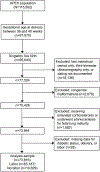Association of Labor With Neonatal Respiratory Outcomes at 36-40 Weeks of Gestation
- PMID: 31403604
- PMCID: PMC6794151
- DOI: 10.1097/AOG.0000000000003415
Association of Labor With Neonatal Respiratory Outcomes at 36-40 Weeks of Gestation
Abstract
Objective: To evaluate whether labor is associated with lower odds of respiratory morbidity among neonates born from 36 to 40 weeks of gestation and to assess whether this association varies by gestational age and maternal diabetic status.
Methods: We conducted a secondary analysis of women in the Assessment of Perinatal Excellence obstetric cohort who delivered across 25 U.S. hospitals over a 3-year period. Women with a singleton liveborn nonanomalous neonate who delivered from 36 to 40 weeks of gestation were included in our analysis. Those who received antenatal corticosteroids, underwent amniocentesis for fetal lung maturity, or did not meet dating criteria were excluded. Our primary outcome was composite neonatal respiratory morbidity, which included respiratory distress syndrome, ventilator support, continuous positive airway pressure, or neonatal death. Maternal characteristics and neonatal outcomes between women who labored and those who did not were compared. Multivariable logistic regression models were used to evaluate the association between labor and the primary outcome. Interactions between labor and diabetes mellitus and labor and gestational age were tested.
Results: Our analysis included 63,187 women who underwent labor and 10,629 who did not. There was no interaction between labor and diabetes mellitus (P=.90). However, there was a significant interaction between labor and gestational age (P=.01). In the adjusted model, labor was associated with lower odds of neonatal respiratory morbidity compared with no labor for neonates delivered from 36-39 weeks of gestation. A 1-week increase in gestational age was associated with a 1.2 times increase in the adjusted odds ratio for the neonatal outcome comparing labor and no labor.
Conclusion: Labor was associated with lower odds of the composite outcome among neonates delivered from 36-39 weeks of gestation. The magnitude of this association varied by gestational age. The association was similar for women with or without diabetes mellitus.
Figures


Similar articles
-
Association between Respiratory Morbidity and Labor in Pregnancies with Gestational Diabetes Mellitus.Am J Perinatol. 2021 Mar;38(4):313-318. doi: 10.1055/s-0040-1716483. Epub 2020 Sep 6. Am J Perinatol. 2021. PMID: 32892330
-
Antenatal Corticosteroids and Preterm Neonatal Morbidity and Mortality among Women with and without Diabetes in Pregnancy.Am J Perinatol. 2022 Jan;39(1):67-74. doi: 10.1055/s-0040-1714391. Epub 2020 Jul 27. Am J Perinatol. 2022. PMID: 32717749 Free PMC article.
-
Induction of labor before 40 weeks is associated with lower rate of cesarean delivery in women with gestational diabetes mellitus.Am J Obstet Gynecol. 2016 Mar;214(3):364.e1-8. doi: 10.1016/j.ajog.2015.12.021. Am J Obstet Gynecol. 2016. PMID: 26928149
-
Antenatal Corticosteroids for the Prevention of Respiratory Distress Syndrome in Premature Twins.Obstet Gynecol. 2016 Sep;128(3):583-91. doi: 10.1097/AOG.0000000000001577. Obstet Gynecol. 2016. PMID: 27500336 Clinical Trial.
-
Does exogenous glucocorticoid administration during pregnancy precipitate the timing of labor? A scoping review.Endocr Connect. 2024 Oct 4;13(11):e240057. doi: 10.1530/EC-24-0057. Print 2024 Oct 1. Endocr Connect. 2024. PMID: 39158582 Free PMC article.
References
-
- Edwards MO, Kotecha SJ, Kotecha S. Respiratory distress of the term newborn infant. Paediatr Respir Rev 2013;14:29–7. - PubMed
-
- Lubow JM, How HY, Habli M, Maxwell R, Sibai BM. Indications for delivery and short-term neonatal outcomes in late preterm as compared with term births. Am J Obstet Gynecol 2009;200:e30–3. - PubMed
Publication types
MeSH terms
Grants and funding
- U10 HD040500/HD/NICHD NIH HHS/United States
- UG1 HD027869/HD/NICHD NIH HHS/United States
- UG1 HD040560/HD/NICHD NIH HHS/United States
- UL1 TR001863/TR/NCATS NIH HHS/United States
- UG1 HD053097/HD/NICHD NIH HHS/United States
- UG1 HD027915/HD/NICHD NIH HHS/United States
- U10 HD040485/HD/NICHD NIH HHS/United States
- UL1 TR003167/TR/NCATS NIH HHS/United States
- U10 HD034116/HD/NICHD NIH HHS/United States
- U10 HD027869/HD/NICHD NIH HHS/United States
- U10 HD027917/HD/NICHD NIH HHS/United States
- UG1 HD040485/HD/NICHD NIH HHS/United States
- U10 HD040560/HD/NICHD NIH HHS/United States
- UG1 HD040500/HD/NICHD NIH HHS/United States
- U10 HD040512/HD/NICHD NIH HHS/United States
- U10 HD040545/HD/NICHD NIH HHS/United States
- U01 HD036801/HD/NICHD NIH HHS/United States
- U10 HD053118/HD/NICHD NIH HHS/United States
- UL1 RR024989/RR/NCRR NIH HHS/United States
- U10 HD040544/HD/NICHD NIH HHS/United States
- UL1 TR002548/TR/NCATS NIH HHS/United States
- UL1 RR025764/RR/NCRR NIH HHS/United States
- UG1 HD034116/HD/NICHD NIH HHS/United States
- UG1 HD040544/HD/NICHD NIH HHS/United States
- UG1 HD034208/HD/NICHD NIH HHS/United States
- UG1 HD040512/HD/NICHD NIH HHS/United States
- U10 HD027915/HD/NICHD NIH HHS/United States
- UG1 HD040545/HD/NICHD NIH HHS/United States
- U10 HD034208/HD/NICHD NIH HHS/United States
- U10 HD053097/HD/NICHD NIH HHS/United States
- U10 HD021410/HD/NICHD NIH HHS/United States
- U10 HD036801/HD/NICHD NIH HHS/United States
- U24 HD036801/HD/NICHD NIH HHS/United States
LinkOut - more resources
Full Text Sources
Medical

